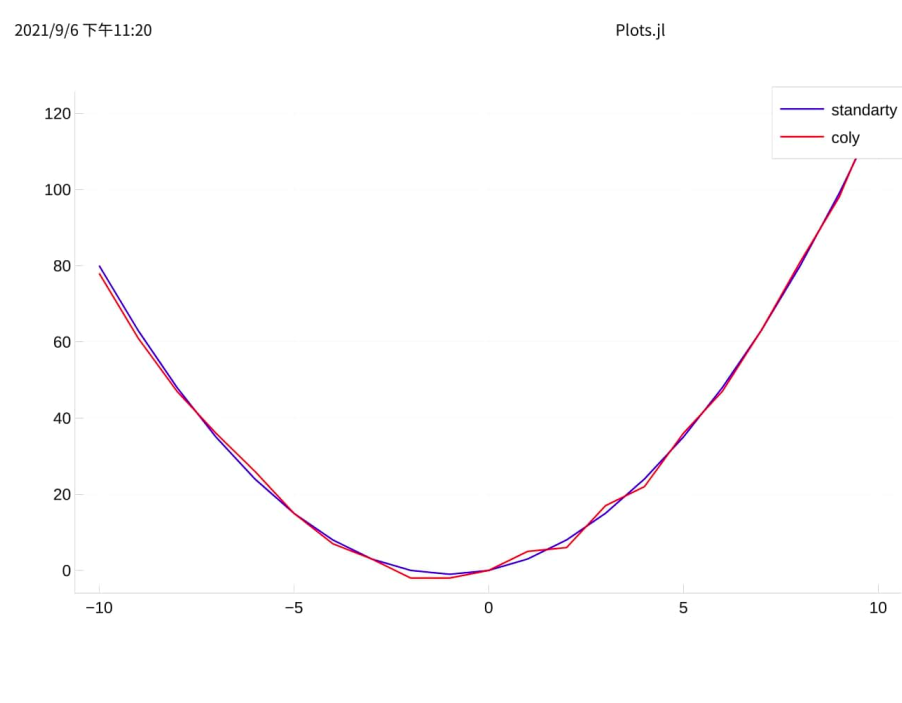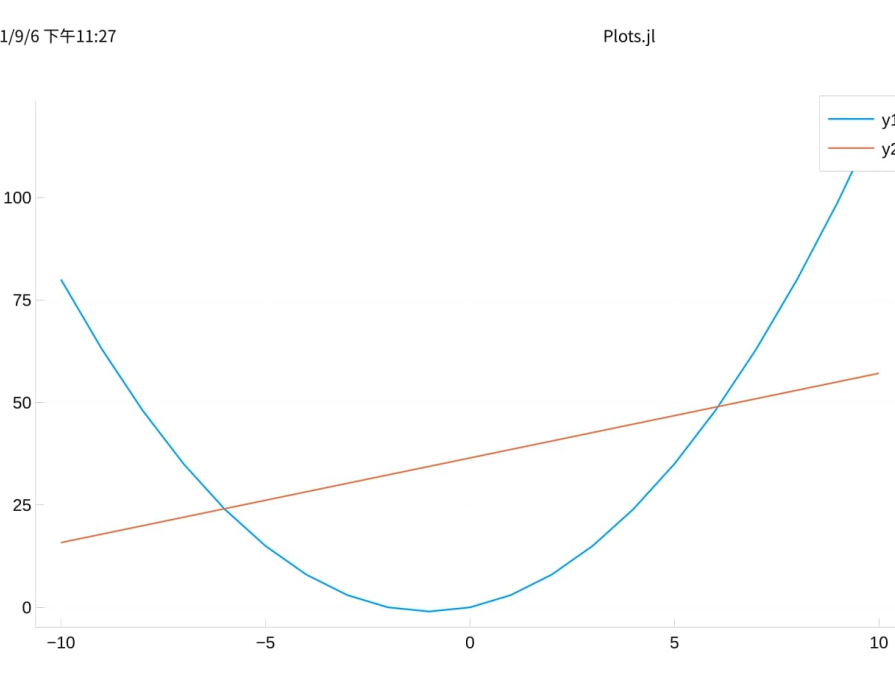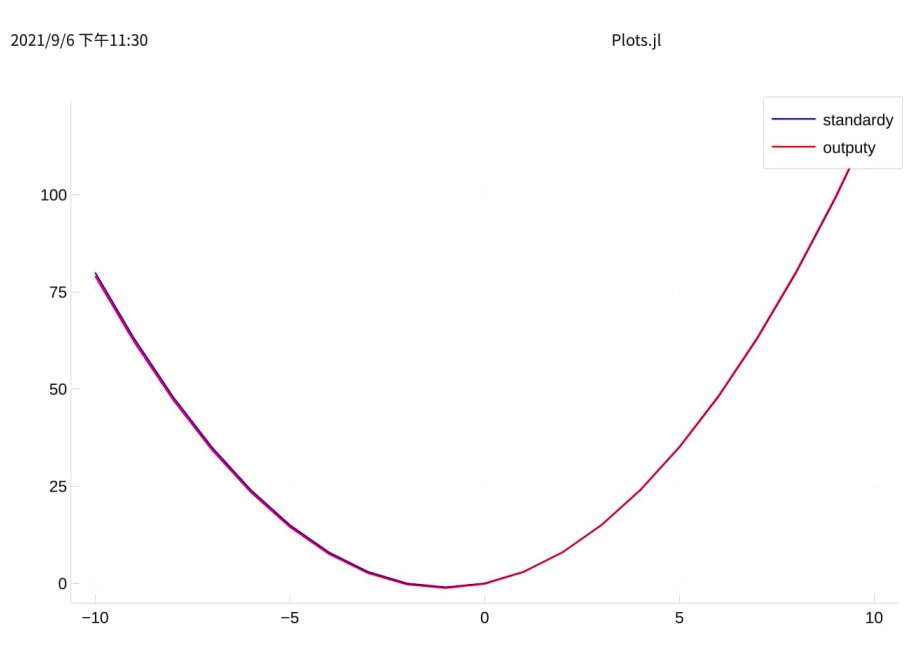MLJ中 线性模型 在回归预测中的简单使用
开始之前
我想向大家介绍一下一些线性模型的用法,以及他们对数据的拟合程度 在我开始学习 MLJ 时,我对他们的拟合能力有所怀疑,经常遇到欠拟合的情况,经过一次简单的测试后,才慢慢了解如何使用模型,处理特征 这里将这个测试介绍给各位
数据准备
我们模拟对函数 f(x) = x^2 + 2x 的拟合,在理想的预测结果 standardy 上加上一点噪音,形成训练用测试结果 coly 接下来依次定义
- f(x)
- standardy
- coly
f(x) = x^2 + 2x
colx = DataFrame(x1=-10:10)
coly = f.(colx.x1) + rand(-2:2, length(colx.x1))
standardy = f.(colx.x1)
再绘制下图像
plot(colx.x1, standardy, label="standarty", color=:blue)
plot!(colx.x1, coly, label="coly", color=:red)

模型介绍
拟合数据我们使用 Ridge 回归,他在损失函数上添加了 L2 正则化
\begin{array}{cl} {\min \limits_{w, b}} & {\dfrac{1}{n}\sum_{i = 1}^n (w^{\top} x_i + b - y_i)^2} \\ {\text{s.t.}} &{\|w\|_2^2 \le t} \end{array}
\tag{6} 在 MLJLinearModels 中,RidgeRegressor 为
Ridge regression model with objective function
其中参数有
- lambda (Real): strength of the L2 regularisation.
fit_intercept(Bool): whether to fit the intercept or not.- penalize_intercept (Bool): whether to penalize the intercept.
- solver: type of solver to use (if nothing the default is used). The solver is Cholesky by default but can be Conjugate-Gradient as well. See ?Analytical for more information.
详细介绍以下 fit_intercept 和 penalize_intercept ,去 Slack 问了以下,大致可以理解为
fit_intercept在假设函数上是否添加 偏差(bias)penalize_intercept是否惩罚偏差,修改其数值
接下来模型训练,直接调优得到最优模型,得到输出结果
using MLJLinearModels, StableRNGs
rng = StableRNG(1234)
ridge = RidgeRegressor()
r_lambda = range(ridge, :lambda, lower = 0.01, upper = 10, scale=:linear)
tuning = Grid(resolution = 20, rng=rng)
resampling = CV(nfolds = 6, rng=rng)
self_tuning_model = TunedModel(model = ridge,
range = r_lambda,
tuning = tuning,
resampling = resampling,
measure = rms
)
self_tuning_mach = machine(self_tuning_model, colx, coly)
fit!(self_tuning_mach)
best_model = fitted_params(self_tuning_mach).best_model
best_mach = machine(best_model, colx, coly)
fit!(best_mach)
outputy = predict(best_mach, colx)
然后我们通过图像查看拟合程度
plot(colx.x1, standardy, label="standardy", color=:blue)
plot!(colx.x1, outputy, label="outputy", color=:red)
可以看到,欠拟合了

添加特征
应对欠拟合的情况我们可以通过添加特征来解决 回到上面的问题,由于 f(x) = x^2 + 2x ,提供的数据中只有 x1=x 一个特征,我们尝试再添加一个特征 x2=x^2
let g(x) = x^2
colx.x2 = g.(colx.x1)
self_tuning_machine = machine(self_tuning_model, colx, coly)
fit!(self_tuning_machine)
best_model = fitted_params(self_tuning_mach).best_model
best_mach = machine(best_model, colx, coly)
fit!(best_mach)
outputy = predict(best_mach, colx)
plot(colx.x1, standardy, label="standardy", color=:blue)
plot!(colx.x1, outputy, label="output", color=:red) |> display
end

可以看到,挺完美 那我们再添加一个特征 x3=x^3
let g(x) = x^3
colx.x3 = g.(colx.x1)
self_tuning_machine = machine(self_tuning_model, colx, coly)
fit!(self_tuning_machine)
best_model = fitted_params(self_tuning_mach).best_model
best_mach = machine(best_model, colx, coly)
fit!(best_mach)
outputy = predict(best_mach, colx)
plot(colx.x1, standardy, color=:blue, label="standard")
plot!(colx.x1, outputY, color=:red, label="ouputy") |> display
end

最后说明
这次测试没有使用训练集和测试集,相当简陋,只是作为实验